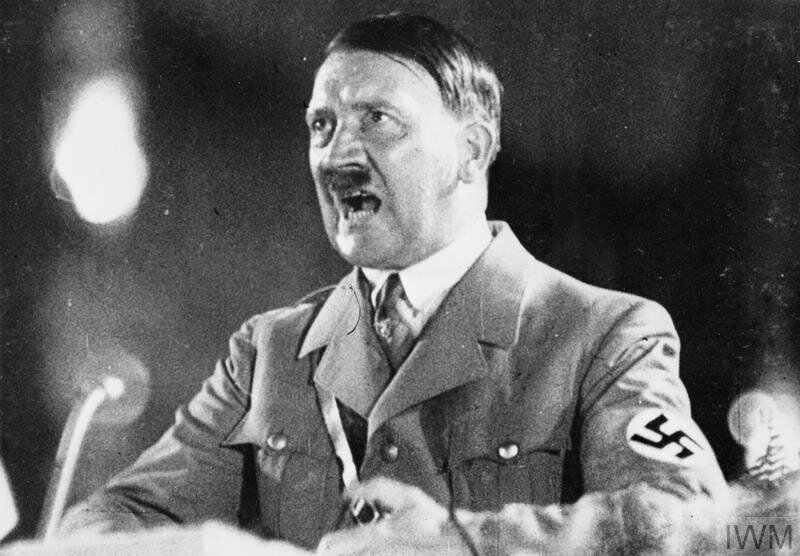Zoomacademia.com – Adolf Hitler was one of history’s most notorious figures, responsible for the outbreak of World War II and the horrors of the Holocaust. Born on April 20, 1889, in Austria, Hitler rose to power as the leader of Nazi Germany, leading a regime that committed widespread atrocities and reshaped the world in devastating ways. His pursuit of a racially “pure” society and territorial expansion resulted in the deaths of millions.
Early Life
Adolf Hitler was born into a lower-middle-class family and had a troubled upbringing. As a child, he faced the death of his younger brother and later his father, which affected him deeply. His school years were marked by poor performance, and he eventually dropped out. Hitler dreamed of becoming an artist, but he failed to gain admission to the Academy of Fine Arts in Vienna. His early failures and hardships contributed to his growing frustration and radical ideas.
In 1914, when World War I broke out, Hitler enlisted in the German Army, where he served on the front lines. He was wounded and awarded medals for bravery, including the Iron Cross. However, Germany’s defeat in 1918, followed by the harsh conditions of the Treaty of Versailles, left him angry and bitter, feeling betrayed by his nation’s leaders.
Rise to Power
After World War I, Hitler joined the German Workers’ Party, a small nationalist group. He quickly rose through the ranks due to his powerful speaking skills and charisma. The party was later renamed the Nazi Party. Hitler’s speeches, which focused on German nationalism, anti-Semitism, and a rejection of the Treaty of Versailles, resonated with many Germans who were struggling in the post-war economic crisis.
In 1923, Hitler led a failed coup attempt, known as the Beer Hall Putsch, to overthrow the government. He was arrested and imprisoned for treason, during which he wrote “Mein Kampf” (“My Struggle”), a book outlining his extreme nationalist and racist ideologies. In the book, he expressed his desire to expand Germany’s territory and eliminate what he considered “inferior races,” particularly Jews.
By 1933, Germany was in turmoil, with economic depression and political instability providing fertile ground for Hitler’s rise. He was appointed Chancellor of Germany, and within a year, he had consolidated his power by dismantling democratic institutions, silencing opposition, and establishing a totalitarian regime.
Nazi Ideology and the Third Reich
Under Hitler’s rule, Nazi Germany was built on a foundation of racism, militarism, and expansionism. Hitler believed that Aryans, particularly Germans, were the superior race and that they needed “Lebensraum” (living space) in Eastern Europe to thrive. His anti-Semitic beliefs led to the persecution and systematic extermination of Jews as well as other minorities such as Romani people, disabled individuals, and political opponents.
The Nuremberg Laws of 1935 formalized the racial discrimination against Jews, stripping them of their citizenship and civil rights. This was only the beginning of what would become the Holocaust, the planned genocide of six million Jews and millions of others, including Soviet prisoners of war, Romani people, and disabled individuals.
World War II
Hitler’s aggressive foreign policy and desire for territorial expansion led to the outbreak of World War II. In September 1939, Germany invaded Poland, prompting Britain and France to declare war. Hitler’s forces used a new military tactic called Blitzkrieg (“lightning war”), which involved rapid, overwhelming attacks. Germany quickly conquered much of Europe, including France, Belgium, and the Netherlands.
However, in 1941, Hitler made two major strategic mistakes: he launched an invasion of the Soviet Union, and he declared war on the United States. These decisions led to a prolonged war on multiple fronts, weakening Nazi Germany’s ability to sustain its conquests.
As the war raged on, Nazi forces also carried out the Final Solution, Hitler’s plan to exterminate the Jewish population of Europe. Concentration camps and extermination camps like Auschwitz, Treblinka, and Sobibor became sites of mass murder.
Hitler’s Downfall and Death
By 1944, the Allies had gained the upper hand in the war. After the successful D-Day invasion in Normandy, France, Allied forces began to push German forces back. In the east, the Soviet Union was advancing rapidly toward Germany.
In April 1945, as Allied troops closed in on Berlin, Hitler retreated to his bunker, where he spent his final days. On April 30, 1945, with Germany facing inevitable defeat, Hitler committed suicide alongside his newly married wife, Eva Braun. Less than a week later, Germany surrendered to the Allies, ending World War II in Europe.
Legacy
Adolf Hitler’s legacy is one of unparalleled destruction and human suffering. His totalitarian regime, built on hatred, fear, and violence, led to the deaths of more than 60 million people during World War II. The Holocaust, which saw the systematic murder of six million Jews, remains one of the darkest and most horrific events in human history.
Hitler’s life and actions have been studied extensively, serving as a reminder of the dangers of unchecked power, racism, and extremism. His dictatorship shows how propaganda, manipulation, and fear can lead to immense suffering when a society abandons democratic values and human rights. The aftermath of Hitler’s rule profoundly influenced the modern world, shaping international law, human rights movements, and global diplomacy.







